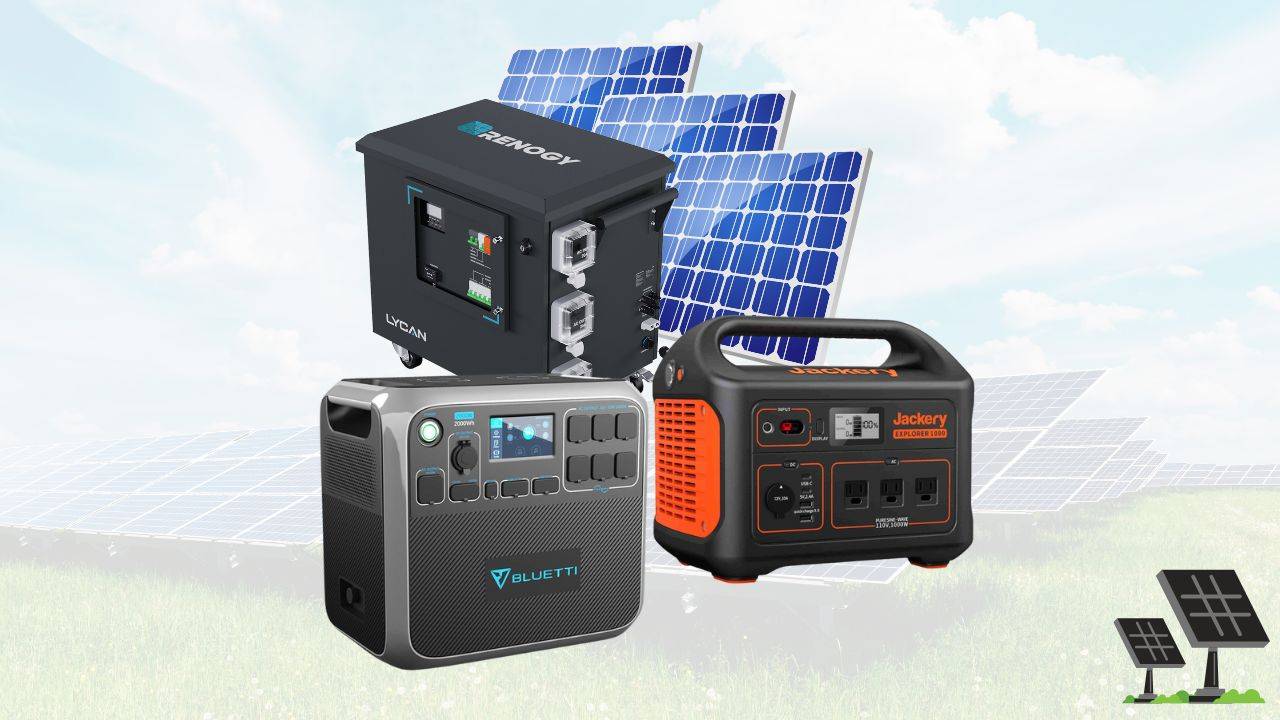Choosing a solar generator shouldn’t feel like cramming for an engineering exam.
Watts, volts, lithium vs. lead-acid… it’s a lot to take in, especially if you’re new to clean energy. But if you’re looking for a quiet, eco-friendly way to keep your devices running — whether at home, on the road, or off the grid — you’re in the right place.
This guide covers everything you need to know:
✔️ What a solar generator actually is
✔️ How it works (in plain English)
✔️ What to look for (and what to avoid)
✔️ And most importantly — which brands are worth your trust
We’re not just talking about power output here. We’ll explore how each brand handles sustainability, battery life, and long-term reliability — so you can choose something that fits your lifestyle and your values.
Let’s plug into the world of solar generators — and find the one that’s just right for you.
What Is A Solar Generator?
A solar generator is a portable power system that captures energy from the sun using solar panels, stores it in a built-in battery, and converts it into usable electricity through an inverter. It typically includes four main components: solar panels, a charge controller, a battery, and an inverter.
In the off-grid mode, solar generators use solar panels to charge up, so manufacturers sometimes offer special “solar generator + panel” deals.
Most solar generators are made to be portable — designed as a sturdy box that contains the battery, inverter, and the control circuits.
On the outside, a solar generator usually has:
- Input ports for charging from the wall, solar panels, and the car
- Multiple outlets, including 110/120V AC ports, 12V DC ports, and USB ports
- Control display that shows the power use, battery information and sometimes access to settings (Bluetti AC200P & EP500)
However, not all solar-powered generators are the same, and not all generators work with all solar panels, even flexible solar panels. There are a few things you need to know before you go shopping.
But first, let me explain how these power stations work.
How Do Solar Power Generators Work?
Every solar generator today consists of two main parts:
When you plug your device into a solar generator you’re basically using the power stored in its battery.
You can charge it in three ways:
- Grid Charging
- Solar Charging
- Car Charging
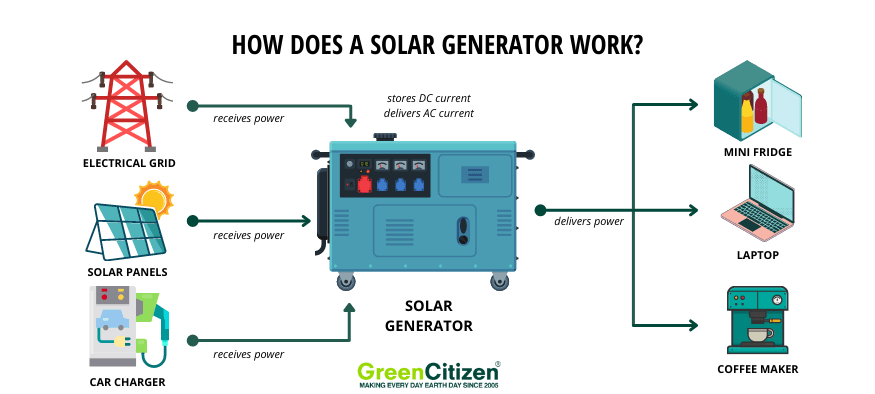
Grid Charging
This is the easiest way — just plug the solar powered generator into a wall outlet and charge it like any battery-run device until it beeps 100%.
This is also the fastest way. EcoFlow solar generators can go from 0-80% in just one hour via grid charging.
However, I don’t need to tell you that grid charging is only possible when you have access to… well, the grid.
This is why we value and rate solar generators for their ability to take charge from solar panels in the first place.
Solar Charging
Solar panels provide free and clean power during the day and for many users, the main point of having a solar power generator is to be able to charge it from the sun.
Solar charging speed depends on the following:
- Size and number of your panels
- Size of the battery
- Solar input power that the generator can take
For solar charging, you need a special solar adapter cable that some manufacturers include in the solar generator kit.
An average solar charging time is around 5 hours, but large generators like the Bluetti EP500 have a dual-charging mode which lets you charge from the grid and solar at the same time.
This way you can charge even a 5,000Wh battery in just 1 hour.
Car Charging
This is definitely the slowest way of charging, but here’s the deal:
If you have to drive all night and need your solar generator locked and loaded by tomorrow morning, that 12V car charger becomes your best friend.
The Bluetti AC200P, for example, takes 14 hours to top off with a 12V charger.
What to Look For When Buying A Solar Powered Generator
Always Go Portable
Whether you need a solar generator to take camping, load aboard your boat, or keep at your home as backup power, you need a product you can carry relatively easily.
If you’re an outdoorsy type, you already know what I’m talking about. You already have a lot of gear to haul around, and to be honest, a solar generator is not the lightest item on the list.
“But I don’t plan to take mine anywhere,” you say.
Well, I’m sure that the good people of Houston didn’t plan to go anywhere as well, but when Harvey struck in 2017 and flooded the whole area, many of them were running for their lives.
Believe me when I say that portable is always better, so you best choose one with a solid carrying handle.
High Solar Input and Charging Speed
The solar input wattage tells you how much power the generator can receive from solar panels.
For example, the Bluetti AC200P has a solar input of 700 watts. This means that you can hook it up to 7x100W or 3x200W solar panels and its 2,000Wh battery will recharge in 3-4 hours.
Such efficient solar charging wouldn’t be possible without the MPPT (Multiple Power Point Tracking) controllers.
This device evens out the voltage difference between an undercharged battery and solar panels. As a result, almost all the solar energy they produce is used to charge the generator.
The MPPT controller is a standard feature of many modern solar generators, but please go through the specs sheet before you buy.
So to conclude, if fast solar charging is your priority, look for solar generators that offer plenty of solar input.
On the other hand, if you want to fully use the enormous 1,200W solar input of the Bluetti EP500 and fill up its 5,100Wh battery, you’ll have to deploy 12x100W or 6x200W solar panels.
There’s no magic to it. Having high solar input is always good, but you’ll definitely need more than two solar panels to reach it.
This is why it’s important to prioritize your needs and buy the solar generator you can make the most use of.
Always ask two questions:
- How much power do I really need?
- How many solar panels can I really deploy?
The More Outlets the Merrier
I rarely need to use all six USB ports, but I always recommend generators with at least three AC outlets.
On the other hand, having a regulated 12V and a fast-charging 60W USB-C port is always a bonus as you can charge the laptop and leave a 110V outlet free for another appliance.
Choose Lithium
Lithium batteries have become the gold standard for solar generators. They are lightweight and can take a deep discharge of up to 80-90% without losing capacity over time.
Talking of losing capacity, these batteries are rated by their life cycles or the number of times you can fully charge and discharge them until their capacity drops below 80%.
These life cycles often spark a lot of heated discussion in the online community — how much is too much and how much is too little?
The answer is simple: If you’re just going to use your solar generator every weekend or twice a month, even a 500-cycle Jackery Explorer would serve you 10 years easily.
On the other hand, if you’ll be using your solar generator day in and day out, choose something with more life cycles, such as the Bluetti AC200P.
You’ll see that some products have lithium-ion (Li-ion) and others have lithium-iron (LiFePO4) batteries.
You can’t go wrong with either kind.
Li-ion batteries weigh less and keep the whole price down, while LiFePO4 batteries are heavier but last much longer (3,000-5,000 life cycles).
Ask About the Company’s Reputation
This one is fairly easy — just look for the company’s website. If the presentation is full of information, downloadable manuals and tech sheets, and instructional videos, you’re probably at the right place.
Reputable companies have issued a number of products over time, improving the capabilities and design in every generation.
These companies usually offer their proprietary solar panels, extra batteries, inverters, and other pieces of solar equipment that are most likely compatible with their solar generators.
Stay away from products you can only buy on e-commerce sites. These are most likely made with substandard components and sold under obscure brand names.
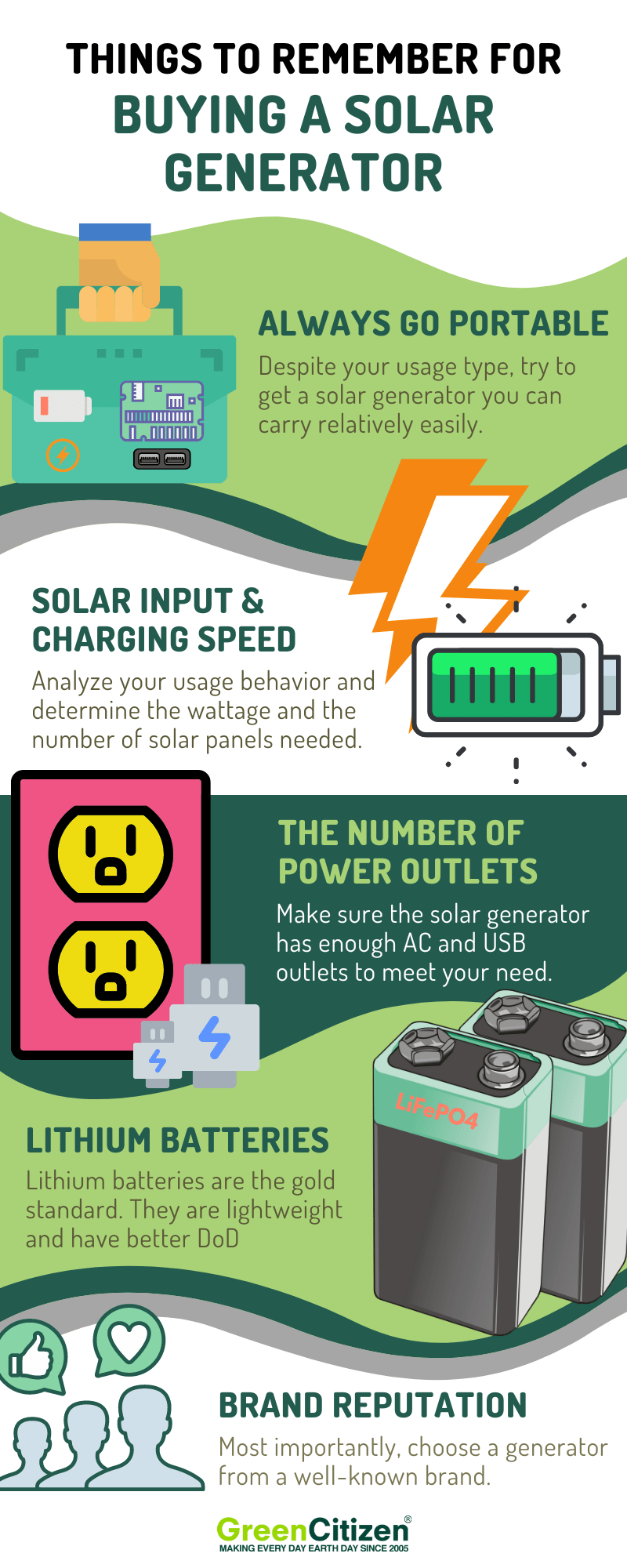
What To Avoid When Choosing A Solar Generator
Say No to Lead-Acid Batteries
Although these batteries use a reliable and time-tested technology and cost less than any type of lithium battery, in my opinion, lead-acids have had their heyday and now it’s time for retirement.
Not only do lead-acid batteries weigh more than lithium batteries, but they are also more sensitive to the depth of discharge (DoD).
If you regularly discharge the battery completely, you are reducing the number of life cycles. The manufacturers usually recommend discharging lead-acid cells to only 50% of their capacity.
On the other hand, lead-acid is still fine for your car since the battery is taking charge as you drive so the capacity rarely drops under 50%.
As an added bonus, lithium batteries have a high energy density, which means they are better suited for power-hungry appliances that drain batteries fast.
Poor Power-Capacity Ratio
Many solar generators failed to enter this Top 10 list because they either had a ton of power rating but low battery capacity or the other way round.
A high power rating of 2,000 or even 3,000 watts means little if the battery can deliver only 1,500 watt-hours of charge.
Your solar generator should be able to run powerful appliances, but it has to be supported by a decent battery.
The other way round also makes little sense — why would you haul almost a 100 lbs weight of batteries if you can barely power a 1,000W microwave with that system.
Among other things, we handpicked the products in this list for their optimum power-battery combos.
How to Determine the Size of Solar Generator that You Need
The size of a solar-powered generator means two things:
- Battery capacity (Wh)
- Power rating (W)
Battery Capacity
The battery capacity determines how long you can power your appliances or devices without having to charge the generator.
This value is measured in watt-hours (Wh).
For example, if a generator has 3,000Wh, it can power a 100W TV for 30 hours, a 60W laptop for 50 hours, or a 1,250W electric grill for 2.4 hours.
To find the right generator capacity for your needs, you need to add up all power ratings you want to use at the same time and multiply them with the number of hours.
Let’s say you need to power:
fridge (160W) + TV (110W) + electric blanket (100W) + lighting (50W) = 420W
For seven hours each day
420W x 7h = 2,940Wh
Based on our computation, you’ll need a generator with a capacity of 2,940Wh. A quick scroll to the comparison table above and the generator you need is the Bluetti AC500 + B300S.
Of course, if you need less power, you don’t need to splurge with such a big battery.
Power Rating
Tells you the total wattage the solar generator can deliver at the same time until the battery runs out.
For example, the 1000W Jackery Explorer can power:
- Coffee maker (300W)
- Fridge (110W)
- Laptop (60W)
And there’s still plenty of power left to charge my GoPro, phone, and drone.
There’s also the surge output, which is the extra-high wattage the generator can deliver over a few milliseconds to fire up machines that suck a lot of power at startup.
Why These 4 Solar Brands Are Winning
1. BLUETTI: Extending Power and Product Lifespan with Smarter Solar Tech
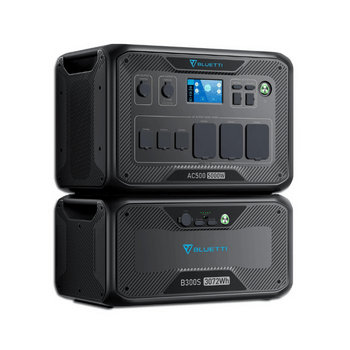
BLUETTI has become a household name in the solar generator space — and for good reason. Their lineup of power stations isn’t just powerful, it’s engineered for longevity, safety, and energy independence. That’s key for sustainability, and it starts at the battery level.
Rather than standard lithium-ion, BLUETTI integrates LiFePO4 (lithium iron phosphate) batteries across most of its flagship models — a chemistry known for thermal stability, non-toxicity, and up to 3,500–6,000 charge cycles before capacity loss. That means your power station can last 10+ years with regular use, compared to the 2–3 years typical of older chemistries — reducing replacement rates and e-waste.
Their high-efficiency MPPT solar charge controllers allow fast, consistent solar charging — with solar input capacities up to 2,400W on advanced systems like the AC500. This ensures users can recharge even large-capacity units like the 2,000Wh+ models in just a few hours under optimal conditions. Pure sine wave inverters and pass-through charging offer clean, stable power for sensitive electronics — essential for medical devices, CPAPs, or laptops.
BLUETTI’s modular architecture (e.g., AC300 + B300) is a game changer. It lets users expand capacity without needing to upgrade the core system, which drastically reduces product turnover and manufacturing waste. These units are also compatible with third-party solar panels, encouraging reuse rather than brand lock-in.
While they don’t currently offer an official recycling or trade-in program, BLUETTI’s focus on longer product cycles, energy efficiency, and off-grid living aligns strongly with sustainability goals. For buyers looking to power up without compromising eco-values, BLUETTI’s mix of rugged design and forward-thinking battery tech makes it a top-tier choice.
2. JACKERY: Powering Portability with Purpose — but What About Longevity?
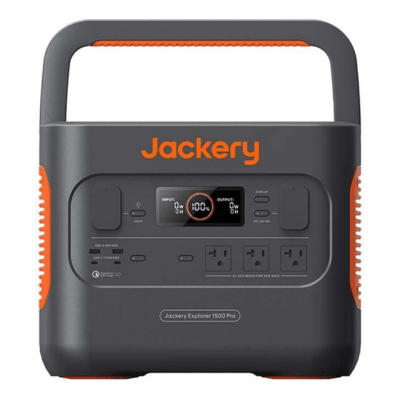
Jackery has long been the go-to brand for portable solar generators — especially for outdoor enthusiasts, vanlifers, and weekend campers. Their compact designs, lightweight frames, and reliable performance made solar feel accessible long before it went mainstream. But how does Jackery stack up on sustainability?
The brand uses NMC (nickel manganese cobalt) lithium-ion batteries in most of its Explorer series. These provide decent energy density and faster charging but have a shorter cycle life than LiFePO4 — typically around 500–1,000 cycles, meaning they may last 2–5 years with consistent use. That’s something sustainability-focused buyers should note, especially if seeking long-term backup power.
Jackery’s systems feature MPPT charge controllers, pure sine wave inverters, and multiple AC/DC outputs, making them versatile for small appliances and devices. Their solar panels — like the SolarSaga series — fold for easy transport and plug-and-play setup, making off-grid solar intuitive. But they tend to be proprietary, meaning less flexibility if you want to mix and match brands.
On the green front, Jackery has taken small but notable steps. In 2021, they launched a “Solar Way Forward” initiative, donating solar gear to communities in need and supporting low-carbon education campaigns. However, there’s currently no recycling program, no take-back scheme, and minimal transparency about material sourcing or carbon goals — areas where more eco-conscious brands are pulling ahead.
Still, for users seeking a grab-and-go solar solution with reliable performance and user-friendly design, Jackery remains a solid brand. Just be mindful: the convenience may come with a shorter product lifespan and fewer sustainability safeguards. Ideal for occasional use — but not the most circular option for long-term clean energy reliance.
3. ECOFLOW: High-Performance Solar With Circularity on the Radar
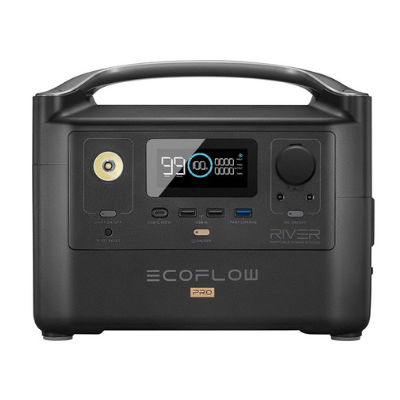
EcoFlow doesn’t just sell solar generators — they sell the dream of an uninterruptible, self-powered lifestyle. Best known for their Delta and River series, EcoFlow pushes the envelope on fast-charging technology, smart energy management, and yes — even sustainability.
Let’s talk tech first. EcoFlow generators are powered by NMC lithium-ion batteries, offering high energy density and lighter weight — but, like Jackery, these come with a cycle life of about 800–1,000 cycles. However, EcoFlow offsets this by building modular systems like the Delta Pro, which supports expandable batteries and can be part of a full home backup ecosystem — complete with solar input, AC output, and smart panel integration.
And here’s where it gets interesting. EcoFlow’s patented X-Stream fast charging can recharge some units from 0–80% in under one hour using wall outlets, reducing reliance on gas-powered generators during outages. For solar input, units like the Delta Pro accept up to 1,600W, while MPPT controllers and pure sine wave inverters ensure clean, efficient energy transfer.
From a sustainability standpoint, EcoFlow is one of the few brands publicly addressing lifecycle thinking. Their EcoFlow Trade-In Program offers credit for old units, encouraging users to upgrade without sending electronics to landfills. The company is also actively developing battery second-life programs, suggesting that repurposing used cells may soon become part of their sustainability roadmap.
Although they still use NMC chemistries (with higher mining impact than LiFePO4), EcoFlow’s modular scalability, emerging circularity plans, and energy independence focus are setting new standards. For those who want cutting-edge tech and a glimpse of solar’s sustainable future, EcoFlow is one of the most forward-thinking names in the game.
4. RENOGY: The Systems Thinker Behind Off-Grid Sustainability
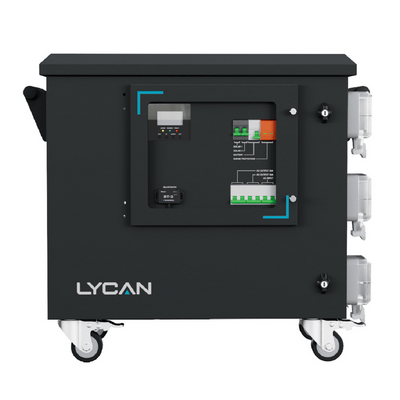
While many solar generator brands focus on plug-and-play convenience, Renogy is thinking bigger — and longer-term. The brand started with DIY solar panel kits and evolved into a full-scale renewable energy ecosystem provider, serving everyone from RV travelers to tiny homeowners to full-blown off-grid homesteaders.
What makes Renogy stand out is its systems-based approach. Their portable power stations — like the Phoenix series — are only one part of a broader energy portfolio. Renogy’s deep-cycle LiFePO4 batteries, MPPT charge controllers, inverters, and solar panels all integrate, giving users control over every part of the energy equation. That means less reliance on throwaway devices and more opportunity for repairs, upgrades, and reuse — which is at the heart of sustainable design.
Their newer solar generators feature LiFePO4 chemistry, known for thermal stability, non-toxic composition, and cycle lives up to 4,000+ charges. This gives Renogy a strong edge in the longevity department, with products that can last 10+ years with regular use. Paired with high solar input capacity, pure sine wave output, and smart Bluetooth monitoring, their systems are built not just to power devices — but to support entire eco-conscious lifestyles.
On the ethics side, Renogy has taken steps to align with ESG standards and has expressed public support for decentralized renewable energy access. However, they still lack a formal recycling or trade-in program, and details around supply chain sustainability are limited.
That said, if you’re building a solar setup from scratch or looking to graduate from portable-only solutions, Renogy is a brand worth rooting for. Their long-term vision, durable tech, and modular upgrades make them a smart pick for buyers who think beyond weekend camping — and toward total energy autonomy.
Benefits Of A Solar Generator
Solar generators have many benefits over fuel-powered generators.
Delivers Free and Clean Energy
Once you pay for the solar power generator and the panels to go with it, everything else is pretty much free. You have an unlimited supply of energy from dawn to dusk, no matter how far from the nearest outlet.
With a solar generator, I don’t have to think about fuel price fluctuations. Solar all the way, baby!
Has Low Running Cost
Since there’s no fuel, no lubricants, and no moving parts that can wear out, solar generators need very little maintenance.
If you charge it as instructed, take care of the battery, and not try anything your generator isn’t made for, you won’t have to replace anything for many years.
Lets You Hear The Leaves
Back in the day you could easily tell if there’s another campsite nearby by the characteristic rumbling sound of a gas generator.
Solar generators are virtually noiseless and in my opinion much more wildlife-friendly. I‘m sure that Mrs. Squirrel cares little about the noise your old gas generator used to make.
On the other hand, if you plan to use the generator inside, keep in mind that cooling fans still produce a kind of whirring noise when engaged to full power.
Make sure you read user reviews to confirm the manufacturers’ claims on noiseless fans.
Take it Everywhere You Go
Gas-powered generators need an IC engine and a fuel tank, both of which add serious bulk to the whole rig.
Solar generators, on the other hand, use lithium batteries that make the total package much more compact and portable.
You don’t see any carrying handles on gas generators, eh?
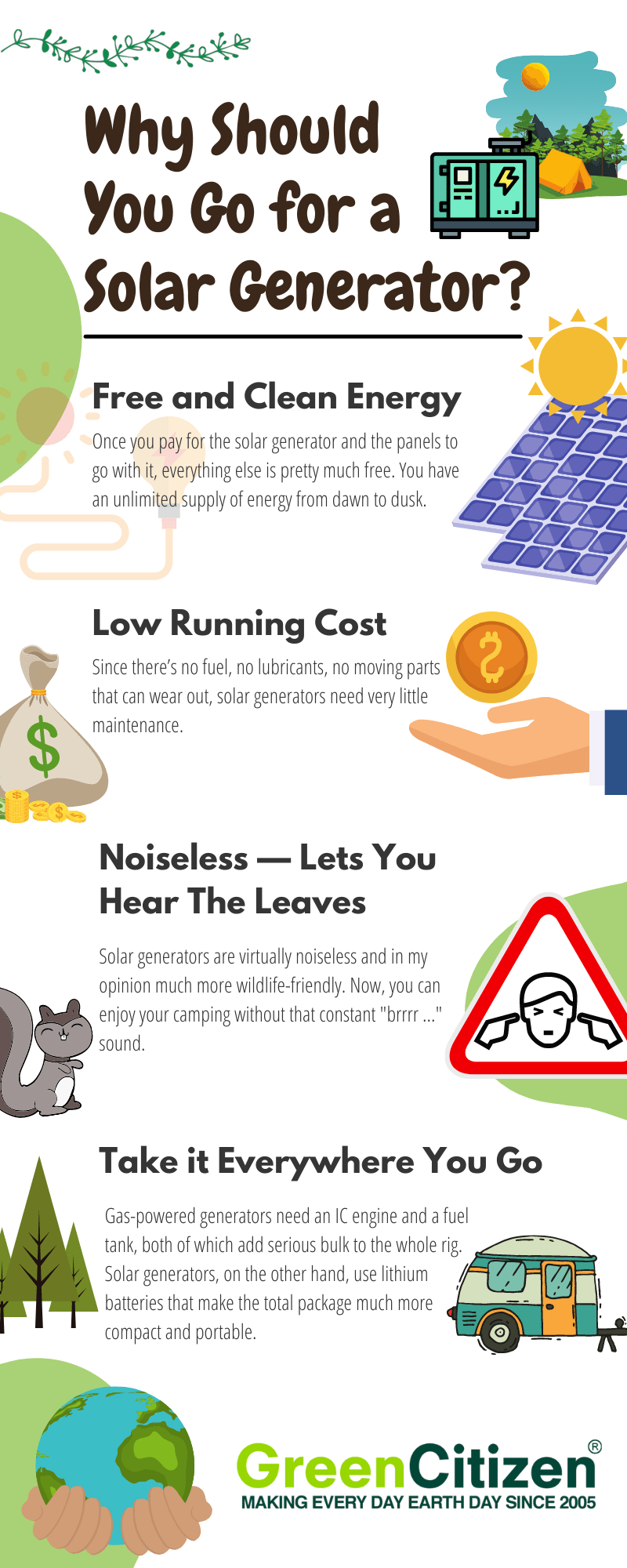
How to Maintain a Solar Generator?
Apart from keeping it clean with a soft cloth, all the maintenance tips are more-less similar to any piece of electronic equipment.
Don’t Let It Get Wet
While some solar powered generators have some degree of water resistance, it doesn’t mean you can leave yours outside in a rain. If you’re out in the woods, protect it from the elements with a piece of tarp or at least bring it under your tent awning.
Keep It Out of Sunlight
Here’s the deal: Solar panels need a lot of sunlight while the solar generator doesn’t need any. Keep yours in a cooler place so the fans can do their job if the battery gets too hot.
Don’t Let It Catch Cold
The temperature range of most solar generators starts at 0°C or 32°F. If you’re camping in sub-zero conditions, do yourself a favor and bring the generator inside overnight.
Frequently Asked Questions (FAQ)
No, a solar generator cannot power a house. The unit may be able to temporarily power certain household appliances (like your TV unit) and handheld items like power tools, but you cannot expect a solar generator to power everything long-term. It will run out of energy before it can keep up.
Yes, solar generators do really work, but they need to be used with high-capacity solar panels in good condition. Aim for 100-watts solar panels or more and expose them to at least 6-8 hours of sunlight every day. If you live in a cloudy area, you may struggle to harness enough sunlight, so keep that in mind.
You need a solar generator that matches your power requirements. If you’re just going on a camping trip, a 500W generator would be plenty. If you’re looking for emergency power in power outages, you ideally want 2000W or higher.
You need a generator that’s at least 1500W to run a refrigerator during a blackout. In the event of a power cut, a 1500W solar generator would run a fridge for around 6 hours. The higher the wattage, the longer the fridge will run.
The largest solar generator on the market is the Goal Zero Yeti 6000X, which has 6000W of capacity. Designed for outdoor events, cabins, and tiny houses, this large solar generator weighs over 100 lbs.
Yes, you need a generator even if you have solar panels on top of your home. In the event of a power cut, your home will lose power just like any other regular home. In this case, it’s best to have a generator as a backup.
A solar generator can power a freezer, though it may not be for very long depending on the size of the generator and the freezer. A 1500W solar generator could power a large chest freezer for around 3 hours before the battery dies.
Yes, Generac does have a solar generator — the Generac Ecogen unit.
A 20kW generator will run most things in your house. You can expect a 20kW generator to keep your lights on, your electronics working, and your A/C working. If you have a smaller home, you might even be able to power the entire house as normal.
A 10,000-watt generator will run most or all of your critical household appliances. This includes the fridge, freezer, furnace, lighting, and sometimes the A/C.
Power Up Without Burning Out the Planet
Choosing a solar generator isn’t just about picking a power source — it’s about choosing a cleaner, quieter, more sustainable way to live.
Whether you’re camping under the stars, preparing for emergencies, or just looking to ditch noisy gas-powered backups, today’s top solar generator brands offer smart, eco-conscious alternatives that truly deliver. From Bluetti’s long-life LiFePO4 tech to EcoFlow’s trade-in program and Renogy’s system-ready flexibility, you’ve got options that work for you and for the planet.
Still exploring? Bookmark this guide, compare features, and take your time. But if you’re ready to make the switch — your future self (and the air you breathe) will thank you.
Let solar do the heavy lifting — sustainably.
